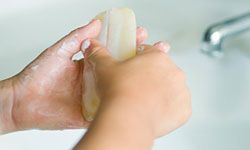What is dermatitis? Dermatitis is a symptom, not a disease, and the word can apply to a wide range of skin conditions. Essentially, dermatitis is any inflammation of the skin that leads to redness, scaling, itching or tiny fluid-filled blisters. Dermatitis can have any number of causes, from fungal infection to fleas, but allergic contact dermatitis occurs when our bodies take in an allergy through our skin and, as a result, become inflamed. Like food allergies, most of these substances are harmless when ingested by people who aren't allergic, but there are also plants (like poison ivy) that produce contact dermatitis in a majority of the population. Oddly, the most common contact allergen isn't even a plant -- it's nickel [source: Kunin].
The quickest way to develop allergic contact dermatitis is by rubbing something you're allergic to on your bare skin. Something we rub on our skin on a regular basis is soap. Ironically, a product that's supposed to cleanse your skin can end up causing you a lot of pain and aggravation. We'll take a look at five of the most common allergens in soaps that cause dermatitis.
Advertisement
